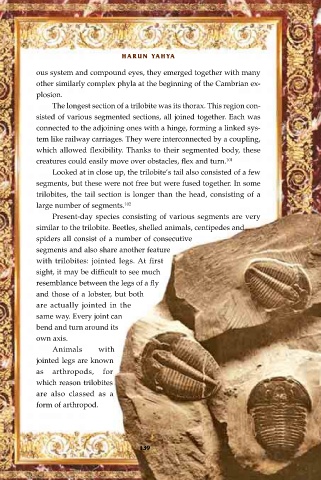Page 141 - The Cambrian Evidence that Darwin Failed to Comprehend
P. 141
HARUN YAHYA
ous system and compound eyes, they emerged together with many
other similarly complex phyla at the beginning of the Cambrian ex-
plosion.
The longest section of a trilobite was its thorax. This region con-
sisted of various segmented sections, all joined together. Each was
connected to the adjoining ones with a hinge, forming a linked sys-
tem like railway carriages. They were interconnected by a coupling,
which allowed flexibility. Thanks to their segmented body, these
creatures could easily move over obstacles, flex and turn. 101
Looked at in close up, the trilobite’s tail also consisted of a few
segments, but these were not free but were fused together. In some
trilobites, the tail section is longer than the head, consisting of a
large number of segments. 102
Present-day species consisting of various segments are very
similar to the trilobite. Beetles, shelled animals, centipedes and
spiders all consist of a number of consecutive
segments and also share another feature
with trilobites: jointed legs. At first
sight, it may be difficult to see much
resemblance between the legs of a fly
and those of a lobster, but both
are actually jointed in the
same way. Every joint can
bend and turn around its
own axis.
Animals with
jointed legs are known
as arthropods, for
which reason trilobites
are also classed as a
form of arthropod.
139

